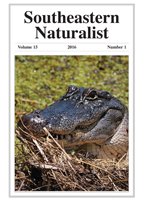Freshwater mussel composition and abundance in stream ecosystems are influenced by changes in environmental and hydrologic forces related to stream size. Mussel assemblages in headwater areas tend to be depauperate but distinctive, with species richness and abundance increasing rapidly with increasing stream size. We compared the mussel assemblages in 3 subwatersheds of the Neches River Basin of east Texas: the small Attoyac Bayou (4th order), the intermediate-sized Angelina River (5th order), and the large mainstem of the upper Neches River (6th order). We conducted timed searches at 75 sites and found 12,860 mussels comprising 26 species. As in other river systems, the smallest stream segment, the Attoyac Bayou, had several species more adapted for low flow rates and stagnant conditions. The largest stream segment, the upper Neches River, had the highest diversity and abundance of unionids. We found that mussel abundances increased as the streamsegment size increased. In addition, we found a change in the species composition, with larger, more riverine species becoming more common as the size of the stream increased. A number of state-listed threatened species occur in the mainstem of the Neches River, which emphasizes the need to preserve undisturbed stretches of larger streams.
How to translate text using browser tools
1 March 2016
Mussel Assemblages in Streams of Different Sizes in the Neches River Basin of Texas
David F. Ford,
Ashley D. Walters,
Lance R. Williams,
Marsha G. Williams,
Neil B. Ford
ACCESS THE FULL ARTICLE

Southeastern Naturalist
Vol. 15 • No. 1
March 2016
Vol. 15 • No. 1
March 2016




